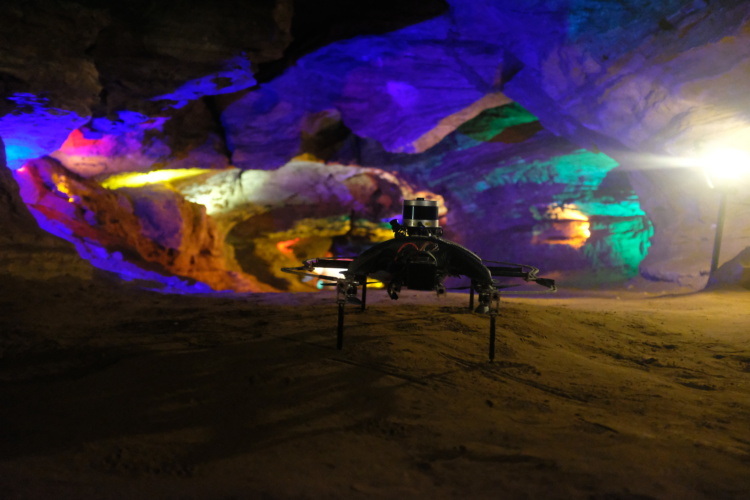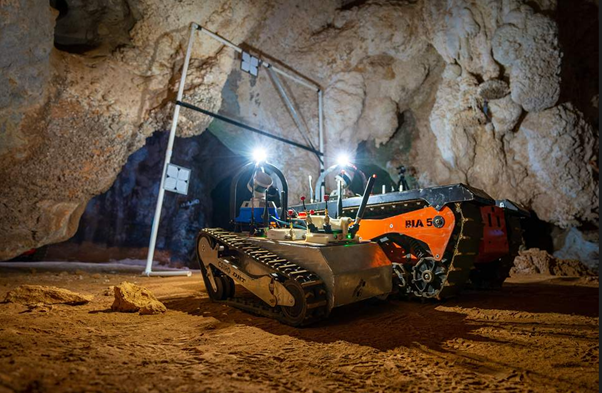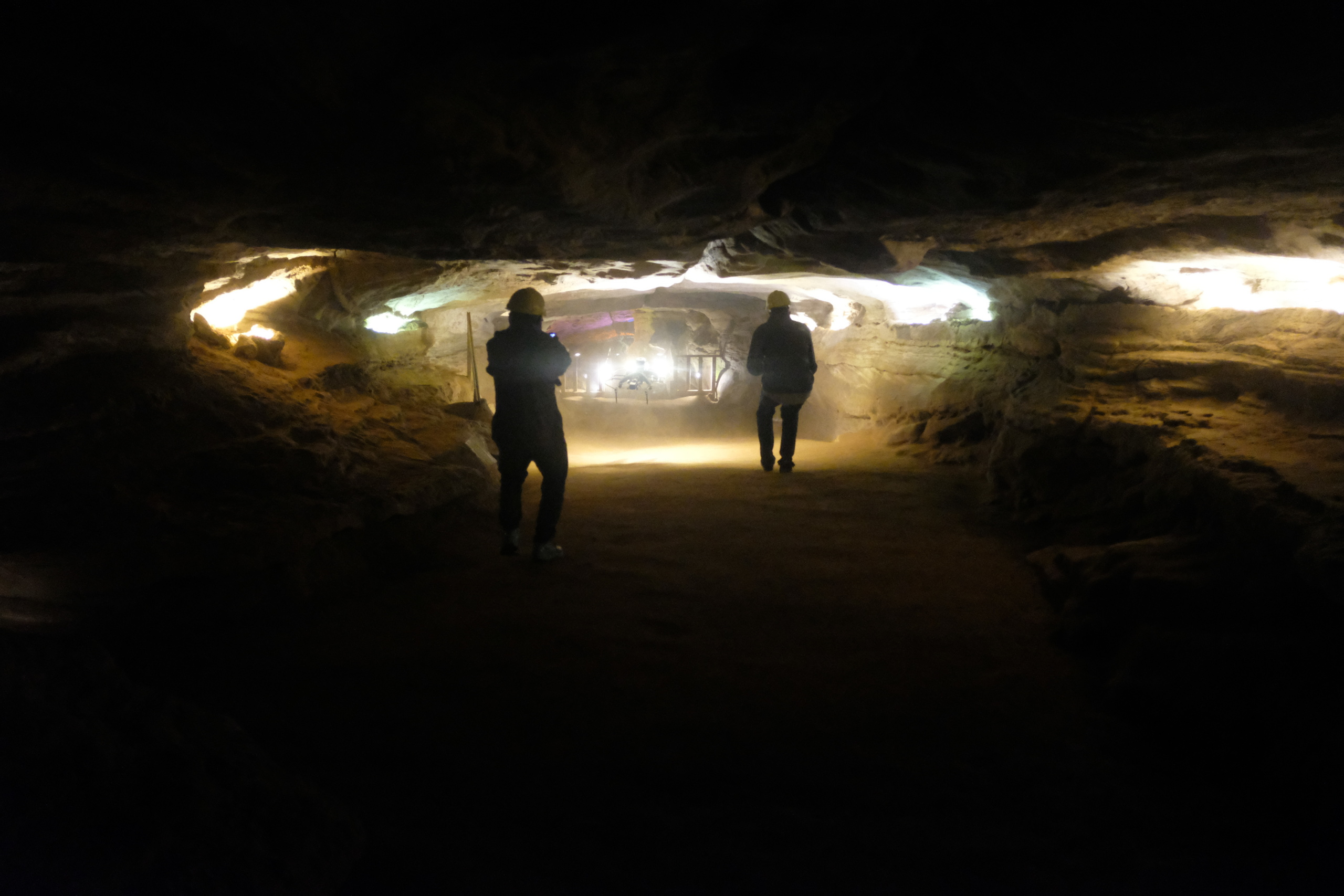This September, eight teams will converge on the US state of Kentucky for a unique competition. At the Louisville Mega Cavern, several metres below the Earth’s surface, an army of machines developed by some of the world’s leading roboticists will search for backpacks, phones, gas leaks and trapped survivors – all the paraphernalia you might associate with an underground disaster. When the dust settles, the winners will walk away with a million dollars in prize money.

The SubT Challenge is the latest in a long line of flagship competitions run by the US government agency DARPA (Defense Advanced Research Projects Agency), a storied organisation founded by Eisenhower in response to Russia’s success with Sputnik. Central to the development of both the Internet and GPS, DARPA is by no means confined to military applications, something reflected in the fact that its ‘D’ has been axed and reinstated multiple times.
Its latest venture, running since 2018, has seen teams developing both real and virtual robotic systems to navigate different underground worlds, including caves, tunnels and subways. Competition courses have been intentionally designed to replicate the dangers of rescue efforts in collapsed mines, post-earthquake search and rescue in urban underground settings, and cave rescue operations for injured or lost spelunkers.
“I had the great pleasure of conceptualising, envisioning what such a challenge would look like, working with a team to craft everything from the structure to the end goals, the scoring function, all of those things,” Dr Timothy Chung, programme manager at DARPA’s Tactical Technology Office (TTO), told The Engineer.
“DARPA’s really interested in identifying and discovering those breakthrough technologies, and one of the places where robotics could really accelerate and have deep impact is in complex, real-world environments…it’s really great to see the concept for this vision continually evolve and grow and materialise in the form of the SubT Challenge we have today.”

The variety of different underground settings, combined with obstacles to simulate the chaos of search and rescue, means that teams involved in the competition rarely rely on a single platform. Instead, most have an assortment of robotic technologies to select from, depending on the setting and the task at hand.
“We have three conventional ground vehicles,” explained Carnegie Mellon University’s Matt Travers, a leader of the Explorer team, which has been one of the top performers in the two ‘Circuit’ events held in the lead up to September’s final.
More In-Depth Features from The Engineer
“Then we have one legged robot, six drones - four of which are homogeneous – and that’s pretty much the overall system. So nominally about 10 platforms, aerial and ground, and some combination thereof goes out and tries to compete in the competition.”
Operating robots underground comes with significant technical challenges, including an absence of GPS, restricted vision, and networking difficulties. While these issues aren’t exclusive to the subterranean world, it brings all of them together in one place, making it the ultimate proving ground for rugged, adaptable robotics.
“The underground is just one example of the types of really complex environments that robots in the future will have to work in, and the SubT environment really lends itself to seeing how we can employ robots while advancing the technology and allowing them to be the first ones in to save human lives,” said Chung.

Drones and robotics have also been advancing at a rapid rate since the competition kicked off back in 2018, and the rules don’t dictate that teams have to stick with the original platforms they proposed at the outset. Rather, in true DARPA spirit, the only real limitations are imagination and engineering capability.
“There’s no rules,” said Travers. “You can do whatever you want. You can restart every year. DARPA doesn’t specify rules in terms of the platform, the strategy, whatever, it’s just ‘here is the playing field, go out and figure out how to do it’.”
According to Chung, the competition setup encourages four particular areas of technology focus: autonomy, networking, perception and mobility. What became clear after speaking to those involved in the SubT Challenge, was that none of these things operates in a silo, and a holistic engineering approach that pays heed to all four is pivotal to solving the problems the competition throws up.
“It’s a fine balancing act,” said Chung. “You can’t have autonomy when you don’t have the ability to share the information that you’ve obtained. You can’t obtain that information without good perception or sensor systems. And of course, if you can’t get there with your mobility solution, there’s nothing to go see.
“Sometimes it’s a trade-off. Sometimes you’ve got to give a little on the networking side and compensate with more autonomous solutions…it’s a really fascinating optimisation problem.”
Travers echoed these sentiments. For the Explorer team - a collaboration between Carnegie Mellon and Oregon State University - that balance between comms and autonomy has been at the crux of the entire SubT Challenge.
“Within this competition in particular, what’s very acutely apparent- at least to me – is that you can’t solve anything in isolation,” said Travers. “You put a perception system together with SLAM (simultaneous localisation and mapping), together with planning, together with control, they all…depend on each other in these complicated and intertwined ways. So the comms problem is hard, but the more complicated problem is the confluence of comms and autonomy, and what’s the correct balance of those two things.

“And the jury’s still out on that. For us, the biggest thing is that if a robot goes down-tunnel and is out of comms and gets stuck, we might as well have not sent it down the tunnel.”
It’s exactly these types of questions that the competition was designed to pose and, to some degree, answer. DARPA’s role is to construct parameters that will encourage the type of research that can be applied in the real world, helping to save lives while advancing the overall state of robotics through collaboration and knowledge sharing.
As well as millions of dollars in prize money, DARPA is also providing funding to several teams in the competition, including Explorer and its close rival CoSTAR, a multi-partner team that includes members from MIT, Caltech and NASA’s Jet Propulsion Laboratory (JPL). It’s a model which dates all the way back to the first DARPA Grand Challenge in 2004 at the Mojave Desert, and which has been hugely successful, turbo charging the evolution of autonomous systems of all different stripes.
“The Grand Challenge model…is really about planting the seed and oftentimes rallying a community together,” said Chung. “And that community benefits from the knowledge sharing that comes about. The SubT Challenge is no different.
“Many of the teams, whether they’re DARPA-funded or not, are releasing a lot of their code, as well as their datasets, all open source, so that the community, everyone rises up with access to the latest and greatest. So even if they’re competitors, you still find a lot of cooperation happening.

“Everyone wins in that scenario, and of course DARPA is keenly interested not only in that community, but also harnessing that advanced technology…so information sharing is integral to what DARPA Challenges bring to the table.”
One might expect the DARPA programme director to exhibit that slightly rose-tinted, Corinthian attitude to the competition, but Chung is not alone in his views. Despite the close rivalry between his Explorer team and CoSTAR, among others, Travers also acknowledges that there is a bigger picture, that the SubT Challenge serves a higher purpose beyond the confines of the actual competition.
“From my understanding and perspective, it’s not really about the winning team,” said Travers. “DARPA is the winning team here. It’s about bringing people together and getting a good understanding of the current state-of-the-art.
“Not any one system from this competition is going to be the optimised system…these technologies are pretty high on the TRL (Technology Readiness Level) already, it’s just seeing what’s going to work as you put them through their paces. At the end of the day, that’s what it’s about.”
But with serious money at stake, not to mention professional pride, the competition isn’t all hugs and kisses and sharing of code. These are still engineers neck-deep in a battle that’s been running for three years, with two teams so far contesting the number one spot. Make no mistake, all eight teams turning up at the Mega Cavern in September want their technology to come out on top.

Of the two lead-in events that have taken place so far, Explorer took top honours at the 2019 Tunnel Circuit just ahead of CoSTAR, but the positions were flipped on the Urban Circuit which followed in February 2020, CoSTAR’s legged Spot robot – of Boston Dynamics fame – proving the difference. A third event, the Cave Circuit, had to be abandoned due to COVID, leaving everything to play for this September. Although both Explorer and CoSTAR began the SubT Challenge with a wealth of robotic and underground experience, the task of building new robotic systems in a short space of time was still significant.
“Our system did really well in the Tunnel Circuit originally,” said Travers. “That first competition was one year in. We built all our own robots and put them together from scratch and got them to work and go out and do something meaningful. Starting from zero, that would be very very difficult. JPL (CoSTAR), clearly they’re not starting from zero either, so they also did well.
“Really it came down to platforms, our ground vehicles looked like they were the more beefy, more robust vehicles for the Tunnel Circuit. In the Urban Circuit, it was very clear to us that (CoSTAR) having the legged Spot robot that could go up and down stairs was the main differentiator…I’d say the biggest systematic error for us was that we did not have a legged robot.”
Some of the innovations seen across the competition so far have been low-tech but high-value. One team attached ‘comms breadcrumbs’ to volleyballs and fired them down a tunnel in an effort to boost networking capability. Another team cleared out a local hardware store of all its powered lighting mid-competition in order to enhance the perception capabilities of its robots. These kind of on-the-fly solutions only come about when robots and their human masters are put to the test in the real world, informing decisions in a way that lab research simply can’t replicate.

At the upcoming Final Event, that innovation and creativity will once again be tested, though prior success will count for little. Explorer and CoSTAR’s earlier victories are consigned to history, with all eight teams starting from scratch. And with the inclusion of caves alongside the more familiar tunnel and urban landscapes, teams will face a combination of terrain that they won’t have previously encountered, meaning any one of the finalists could potentially come out on top. If the Circuit events so far represent two legs of a triathlon, the Final Event is the full three legs together, where weaknesses in one discipline or environment will be exposed.
“What you want at the end of the day is the best all-round athlete who can overcome all three of these sub-domains at one go,” said Chung. “And I think that’s what the teams are preparing for. Certainly DARPA is raising the bar for the challenge at that Final Event.”
But when the last robot has emerged from the dark depths of the Louisville Mega Cavern, and the winners have departed with their million-dollar prize, the SubT journey will be far from over. Rather, it will simply mark the end of the beginning, a jumping-off point for new government investment as well as commercialisation of successful technologies.
“We imagine that there’s going to be quite a long runway for not only many of the technologies, but also the teams, as they continue advancing the technology,” said Chung.
“Now that we know where the next plateau of technological difficulty is upon the conclusion of the SubT Challenge, we’re just going to be setting up continued cycles of advancing and breaking through new barriers.”




Red Bull makes hydrogen fuel cell play with AVL
Formula 1 is an anachronistic anomaly where its only cutting edge is in engine development. The rules prohibit any real innovation and there would be...